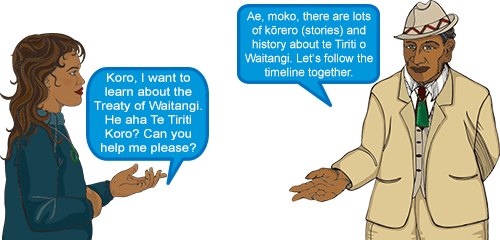
Up to 1830
- There were about 115,000 Māori and about 2000 Europeans living in Aotearoa/New Zealand.
-
 European traders, sealers and whalers along with other European settlers were here.
European traders, sealers and whalers along with other European settlers were here. - New Zealand was populated by many independent Māori tribes with small European settlements scattered throughout the country.
- Māori and Europeans were already trading and the exchange of land for goods was already happening.
-
!["Tu Kaitote, the pa of Te Wherowhero on the Waikato, Taupiri mountain in the distance", Tinted lithograph by J. W. Giles [Alexander Turnbull Library: PUBL-0014-15]](https://christchurchcitylibraries.com/Kids/Treaty-Zone/imgs/Timeline-Tu-Kaitote-1844.png) Māori and Pakeha were living side by side. There was no one set of formal laws and as settlement increased, rules and guidelines were needed.
Māori and Pakeha were living side by side. There was no one set of formal laws and as settlement increased, rules and guidelines were needed. - Both Māori and Pakeha groups asked Britain to provide some sort of protection from the increased population of criminals and misbehaving migrants in New Zealand.
-
![James Busby, British Resident 1833—40 [ HC-651 - Alexander Turnbull Library]](https://christchurchcitylibraries.com/Kids/Treaty-Zone/imgs/Timeline-J-Busby-1833-40.png) James Busby arrived in 1833 as the ‘British Resident in New Zealand’.
James Busby arrived in 1833 as the ‘British Resident in New Zealand’.
1835–1840
- First official flag: the flag of the United Tribes.
![United Tribes Flag [Alexander Turnbull Library, MS-Papers-0009-09-01]](https://christchurchcitylibraries.com/Kids/Treaty-Zone/imgs/Timeline-United-Tribes-Flag-1845.png)
- The New Zealand Company was planning large scale settlement in New Zealand. More and more British immigrants were arriving.
- Conflict was increasing between Māori and non-Māori.
-
He Whakaputanga o te Rangatiratanga o Nu Tireni / Declaration of Independence of New Zealand —
![New Zealand company ships in 1841, Watercolour by Charles Heaphy [Alexander Turnbull Library: B-043-018 ]](https://christchurchcitylibraries.com/Kids/Treaty-Zone/imgs/Timeline-NZ-Company-Ships-1841.png) 34 chiefs signed — first indication that an agreement between Māori and British Crown could be made.
34 chiefs signed — first indication that an agreement between Māori and British Crown could be made. - Captain William Hobson arrived in 1840 as the British Crown’s Lieutenant Governer — his job was to negotiate a treaty with Māori. The crown hoped that New Zealand would become a British Colony.
- 29th January 1840 — Hobson arrived at Waitangi and invited several hundred Māori to Waitangi on the 5th of February 1840.
-
!['Governor William Hobson' by James McDonald, 1913 [Alexander Turnbull Library G-826-1]](https://christchurchcitylibraries.com/Kids/Treaty-Zone/imgs/Timeline-Hobson-1913.png) 29th January — 5th February 1840 — Hobson, with Busby’s help, wrote up a treaty in English.
29th January — 5th February 1840 — Hobson, with Busby’s help, wrote up a treaty in English. - Henry Williams and his son Edward translated the Treaty into Te Reo Māori.
5th and 6th February 1840:The Signing At Waitangi
-
![Mid 20th c picture of the siging of the treaty [Alexander Turnbull Library NON-ATL-0173]](https://christchurchcitylibraries.com/Kids/Treaty-Zone/imgs/Timeline-Signing-M-King-1950.png) The hui with Māori and the Crown began on the 5th February.
The hui with Māori and the Crown began on the 5th February. - Hobson spoke in English of the Crown’s intentions and Henry Williams translated his words into Te Reo Māori.
- 5 hours of discussion and debate followed.
- The English and Te Reo Māori versions of the Treaty were read out to all attending the hui.
- The talking among Māori continued into the night.
- Thursday 6th February the chiefs who were present at the hui decided to sign and return home.
- A total of 43 chiefs signed the Treaty at Waitangi. The first to sign was Hone Heke.
May–August 1840:The Travelling Treaty — Te Wai Pounamu
- May 1840 — Henry Williams negotiated signings in Queen Charlotte Sound and Rangitoto Island.
- Major Thomas Bunbury and Edward Williams sailed on the HMS Herald to the South Island to gather signatures.
-
 30th May 1840 — the Treaty was signed at Ōnuku on Akaroa Harbour. Chiefs Iwikau and Hone Tikao (John Love) signed here.
30th May 1840 — the Treaty was signed at Ōnuku on Akaroa Harbour. Chiefs Iwikau and Hone Tikao (John Love) signed here. - 10th June 1840 — Chiefs Tuhawaiki, Kaikoura and Taiaroa signed at Ruapuke Island.
- 13th June — Signed at Otago Harbour.
- 17th June — Signed at Cloudy Bay.
By the end of 1840 over 500 Māori had signed the Māori text.
- Have a look at another timeline on New Zealand History Online.
- The meaning of the Treaty — what were people agreeing to?
- Interpretation of the Treaty of Waitangi — a look at the language differences between the Te Reo Māori and the English versions of the Treaty.
1841 onwards
!['Scene of the Wairau massacre' painted in 1851 {Alexander Turnbull Library B-103-030]](https://christchurchcitylibraries.com/Kids/Treaty-Zone/imgs/Timeline-Wairau-1851.png) Post Treaty events — conflict and honouring the Treaty
Post Treaty events — conflict and honouring the Treaty
- 1843 — Wairau Affray. Conflict between the New Zealand Company and Māori chiefs Te Rauparaha and Te Rangihaeata came to a head.
- 1844 — Hone Heke, disillusioned with what had happened since the Treaty was signed, decided to protest by chopping down the British flagpole at Russell (known before as Kororāreka).
![Sketch of Hone Heke [Alexander Turnbull Library A-014-003]](https://christchurchcitylibraries.com/Kids/Treaty-Zone/imgs/Timeline-Hone-Heke-Sketch.png)
- 1858 — First Māori King. Waikato chief Te Wherowhero (who had not signed the Treaty) became the first King, taking the name Pōtatau Te Wherowhero.
- 1860–1880 — Dishonouring the Treaty
- 1940–2000s — Honouring the Treaty
- Ngāi Tahu Land Claims against the Treaty started early and were widespread.
- In 1998 Prime Minister Jenny Shipley came to Ōnuku Marae and presented the Crown Apology to Ngāi Tahu.

